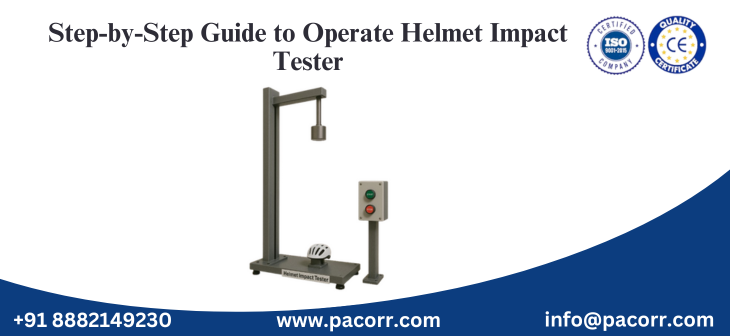
Pacorr Helmet Impact Tester is a critical testing instrument used by manufacturers and safety compliance teams to evaluate the effectiveness of helmets in protecting against head injuries. Designed to ensure helmets meet rigorous safety standards, the Pacorr Helmet Impact Tester provides accurate, consistent, and reliable data essential for helmet certification. The following comprehensive guide outlines the detailed process to operate this advanced testing instrument safely and effectively.
Step 1: Pre-Operation Inspection
Before commencing the helmet testing procedure, it is essential to perform a pre-operation inspection:
- Visual Inspection: Check for any visible damage or irregularities on the machine, ensuring all components such as the impactor, measuring sensors, cables, and the data logger are in proper condition.
- Calibration: Ensure that the Helmet Impact Tester is accurately calibrated. Calibration guarantees the accuracy of the test results. Use standard calibration weights and follow the manufacturer's recommended procedure.
Step 2: Setting Up the Helmet Impact Tester
After completing the inspection, proceed to set up the Helmet Impact Tester:
- Position the Helmet: Firmly secure the helmet on the designated testing platform. It must be positioned accurately according to specified guidelines. Incorrect placement can lead to inaccurate test results.
- Adjust the Impact Height: Determine and adjust the impact height according to the required testing standards (such as ASTM, ISI, ISO standards). This height adjustment determines the severity of the impact.
Step 3: Selection of Appropriate Impact Test
Pacorr Helmet Impact Tester supports various testing protocols based on international standards, including penetration and shock absorption tests:
- Shock Absorption Test: This test evaluates the helmet’s ability to absorb and reduce impact forces. Ensure the test selection matches the helmet's intended use (e.g., industrial, sports, or automotive).
- Penetration Test: Conduct this test to assess resistance against sharp object penetration.
Select the desired test protocol on the instrument’s control panel or software interface clearly marked for user convenience.
Step 4: Configuring Test Parameters
Once the test type is selected, configure specific test parameters on the Helmet Impact Tester:
- Impact Velocity: Input the precise velocity required for the impact test. Typically, standards define these velocities clearly.
- Impact Weight: Choose the correct weight for the impacting mass based on standards such as ASTM F1446 or EN 1078.
- Data Logging Preferences: Set the instrument to record relevant data such as acceleration, force, and impact duration automatically.
Step 5: Performing the Impact Test
With all configurations set, begin the Helmet Impact Testing procedure:
- Initiating the Test: Activate the tester using the start command or button. Ensure the impactor falls freely onto the helmet without interference.
- Monitoring the Test: Continuously observe the test as it proceeds. The helmet’s response and the tester’s function should be closely monitored to ensure everything proceeds as planned.
Step 6: Data Collection and Analysis
Upon completion of the impact:
- Automatic Data Capture: The Pacorr Helmet Impact Tester records all necessary impact data including peak force, energy absorption, and deformation automatically.
- Review the Data: Use the software interface or integrated display to review the recorded data immediately. Check data consistency and note any unusual readings for further analysis.
Step 7: Post-Test Procedures
After conducting the helmet impact test:
- Helmet Inspection: Visually inspect the helmet to note any physical damage or deformation.
- Documentation: Properly document all data collected during the test, including detailed observations and results. Clearly label and file these results for certification or compliance purposes.
- Test Repetition: Conduct additional tests if required by standards or internal quality assurance processes. Multiple tests ensure consistency and reliability in the helmet performance data.
Step 8: Maintenance of Helmet Impact Tester
Routine maintenance ensures the longevity and precision of the Helmet Impact Tester:
- Regular Cleaning: Clean the instrument regularly to remove dust and debris. Use only recommended cleaning materials to prevent damage.
- Periodic Calibration: Schedule regular calibration checks to maintain measurement accuracy.
- Parts Inspection: Periodically inspect critical components such as sensors, impactors, and cables for wear or damage, replacing them as necessary.
Safety Precautions While Operating Helmet Impact Tester
To maintain operational safety, follow these guidelines rigorously:
- Operator Safety: Always wear protective gear, including safety glasses and gloves, while operating the instrument.
- Clear Testing Area: Keep the area around the tester clear to avoid accidental injuries.
- Emergency Procedures: Familiarize yourself with emergency stop functions and other safety features of the tester.
Importance of Accurate Helmet Impact Testing
Accurate testing using Pacorr Helmet Impact Tester directly impacts consumer safety by ensuring helmets meet stringent safety criteria. Reliable impact tests help manufacturers design and refine products to offer superior protection against head injuries, ultimately safeguarding users across diverse environments such as construction sites, roadways, and sporting arenas.
Applications of Pacorr Helmet Impact Tester
Pacorr Helmet Impact Tester is utilized across various sectors including:
- Sports Equipment Manufacturing: Ensuring helmets used in sports like cricket, cycling, and skiing are effective against impacts.
- Industrial Safety Gear: Testing helmets used in construction and manufacturing industries for compliance with global safety standards.
- Automotive and Transportation: Assessing helmets designed for motorbike and motorsport applications to ensure rigorous safety compliance.
Conclusion
Operating the Pacorr Helmet Impact Tester effectively involves thorough preparation, correct setting adjustments, accurate data collection, and meticulous maintenance. Adhering strictly to standardized testing procedures guarantees helmets deliver maximum safety performance. With Pacorr’s advanced and user-friendly Helmet Impact Tester, manufacturers can confidently ensure their products meet and exceed international safety standards, ultimately contributing to safer environments globally.
Thanks to Pacorr Testing instruments, we have all the required quality testing instruments that have helped us to ensure the best quality delivered to our clients.

Danish
Fair Exports Pvt. Ltd.

